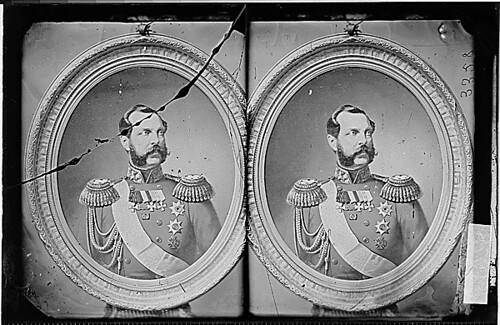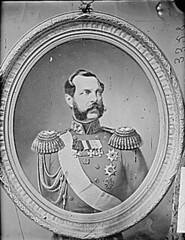
PREV ARTICLE
NEXT ARTICLE
FULL ISSUE
PREV FULL ISSUE
WHO IS THAT GENT WITH LINCOLN AND GRANT? ALEXANDER II

Last week Kerry Rodgers asked: This American Bank Note Company advertising item sold for $1,652 in Archives International Auction XI held in May. It shows Lincoln and Grant flanking a gentleman. The catalog believes him to be a Russian and the item to date from the1860s. Can any reader provide an identification? Tom DeLorey writes: Without doing any research at all, I would guess that the distinguished gentleman with Lincoln and Grant is Prince Albert, the husband of Queen Victoria, deceased in the early 1860's. Joe Boling agrees: The first man who came to mind with Lincoln and Grant is Victoria's Albert. But there were other attributions. Fabienne Burkhalter writes: It could be Maximilian II of Mexico ? Kerry Rodgers thought it could even be Napoleon III. All good and reasonable guesses, but wrong. David T. Alexander writes: The imposing monarch with Lincoln and Grant is Russian Emperor Nicholas I (ruled 1825-1855). Here was a ruler who personified "Emperor and AUTOCRAT of all the Russias..." Pete Smith writes: I could probably find twenty portraits of Russian Tsars or generals wearing their sash and medals that would be similar to the portrait on the American Bank Note Company advertising card. The closest match I could find was Tsar Alexander II. Something he shared with Lincoln was assassination. He was killed by a terrorist bomb on March 13, 1881.

Czar Alexander II of Russia ca. 1860 The first reader to guess correctly was Greg Adams, who provided the above image from the National Archives. Ursula Kampmann, Heath MacAlpine, Robert Bauswell and Pablo Hoffman concur. Pablo writes: The person pictured in the ABNC piece in place of honor between Lincoln and Grant is Aleksandr Nikolayevich, better known to us in English as Alexander II, emperor of Russia (1855-81).
When Russia sold the Alaska territory to the United States in 1867, Czar Alexander II did not take part in the negotiations. Could it be that he did not want to take time away from meticulously manicuring his royal mustache? Czar Alexander II was a true man of the era, sporting mutton chops along with a full mustache. He would have had no problem fitting in with the negotiators of the Alaska purchase. Although even Moscow's top diplomats could not fill the mutton chops of a monarch, the Russian delegation made a manful attempt, with envoy Eduard de Stoeckl emulating the Czar's handlebar mustache and plush sideburns. When the war of the whiskers finally concluded, the two sides reached an agreement. On August 1, 1868, the United States wrote de Stoeckl a check for more than 586,000 square miles in the Alaska territory for $7.2 million. At the time, the deal was with disapproval from some, who called the enormous piece of land "Seward's Folly." But in 1896, the discovery of gold made the recently acquired district far more valuable. To read the complete article, see: Facial Hair Friday: From Russia With Love (blogs.archives.gov/prologue/?p=6293) Bob Julian writes: The portrait shown between those of Lincoln and Grant appears to be that of the Emperor Alexander II (1855-1881) of Russia. The American Bank Note Company had close business dealings with the Russian Treasury in the early to mid 1860s. One of the treasures of the Hermitage numismatic library, which I had the privilege of examining in person, was the specially bound collection of engraved vignettes presented by the ABNC to Alexander II. The ABNC arrangement with the Russian government is well covered in the article "America and Russia, the Credit Notes of 1866," which appeared in the Journal of the Russian Numismatic Society, No. 72, summer 2001. Dennis Tucker of Whitman Publishing writes: When I saw the ABNCo card in last week's E-Sylum, I immediately recognized it from Fred Reed's Abraham Lincoln: The Image of His Greatness (page 147). Reed identifies the mustachioed gentleman as Alexander II, Russian emperor from 1855 to 1881. Alexander was targeted several times over the years by various revolutionaries, and finally in March 1881, in St. Petersburg, he was horrifically and fatally wounded by an assassin's bomb. (A first bomb stopped his bullet-proof carriage, then during the confusion a second bomb was thrown at his feet.) The emperor's son and grandson (both future emperors themselves) saw the assassination first-hand, and it hardened them. The fallout of the murder was hardcore repression and police brutality, pogroms, and suppression of civil liberties. Reed identifies the Lincoln die as ABNCo Lincoln-portrait die number 141 --- Charles Burt's vision of the president, originally created in 1861 for U.S. Demand Notes. Here at Whitman we're working on a monumental follow-up to Reed's The Image of His Greatness, which was very popular and managed to cross the "cultural divide" between mainstream American history books and numismatic books. It will be even bigger than the first volume. Watch for it later this year. Fred Reed writes: Years ago I asked Gene Hessler who this was since the Lincoln portrait on it is from the original ABNCo steel die and steel roller die that I own, and he identified the gentleman in the center as Alexander II of Russia. You'll find it on page 147 of my first Lincoln book, Abraham Lincoln, The Image of His Greatness, nearly full sized. P.S. By the way, I was the purchaser of this item in the recent Archives International Auctions sale, and I'm happy to have it finally since I've been chasing it for years.


A follow-up email from Dave Alexander urged a closer examination of the mustache, making a case for Nicholas I. Could the consensus be wrong?
-Editor
Wayne Homren, Editor The Numismatic Bibliomania Society is a non-profit organization promoting numismatic literature. See our web site at coinbooks.org. To submit items for publication in The E-Sylum, write to the Editor at this address: whomren@gmail.com To subscribe go to: https://my.binhost.com/lists/listinfo/esylum All Rights Reserved. NBS Home Page Contact the NBS webmaster 
|